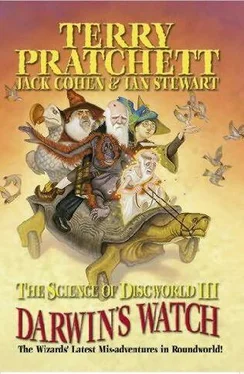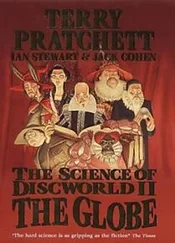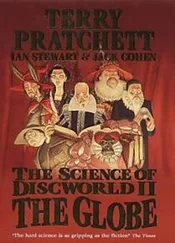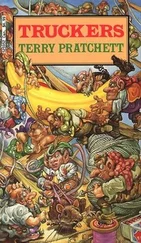Terry Pratchett - The Science of Discworld III - Darwin's Watch
Здесь есть возможность читать онлайн «Terry Pratchett - The Science of Discworld III - Darwin's Watch» весь текст электронной книги совершенно бесплатно (целиком полную версию без сокращений). В некоторых случаях можно слушать аудио, скачать через торрент в формате fb2 и присутствует краткое содержание. Жанр: Фантастика и фэнтези, на английском языке. Описание произведения, (предисловие) а так же отзывы посетителей доступны на портале библиотеки ЛибКат.
- Название:The Science of Discworld III - Darwin's Watch
- Автор:
- Жанр:
- Год:неизвестен
- ISBN:нет данных
- Рейтинг книги:3 / 5. Голосов: 1
-
Избранное:Добавить в избранное
- Отзывы:
-
Ваша оценка:
- 60
- 1
- 2
- 3
- 4
- 5
The Science of Discworld III - Darwin's Watch: краткое содержание, описание и аннотация
Предлагаем к чтению аннотацию, описание, краткое содержание или предисловие (зависит от того, что написал сам автор книги «The Science of Discworld III - Darwin's Watch»). Если вы не нашли необходимую информацию о книге — напишите в комментариях, мы постараемся отыскать её.
The Science of Discworld III - Darwin's Watch — читать онлайн бесплатно полную книгу (весь текст) целиком
Ниже представлен текст книги, разбитый по страницам. Система сохранения места последней прочитанной страницы, позволяет с удобством читать онлайн бесплатно книгу «The Science of Discworld III - Darwin's Watch», без необходимости каждый раз заново искать на чём Вы остановились. Поставьте закладку, и сможете в любой момент перейти на страницу, на которой закончили чтение.
Интервал:
Закладка:
So which is it? A mindless lump of matter which obeys the local rules as it goes along? Or a quasi-intelligent entity with vast computational powers, which has the foresight to choose, among all the possible paths that it could have taken, precisely the unique one that minimises the action?
We know which interpretation we'd choose.
Interestingly, the principle of least action is a mechanical analogue of Feynman's sum-over-histories method in optics. The two really are extremely close. Yes, you can formulate the mathematics of quantum mechanics in a way that seems to imply that light follows all possible paths and adds them up. But you are not obliged to buy that description as the real physics of the real world, even if the mathematics works.
The many-worlds enthusiasts do buy that description: in fact, they take it much further. Not the history of a single photon bouncing off a mirror, but the history of the entire universe. That, too, is a sum of all possibilities - using the universe's quantum wave function in place of the light intensity due to the photon - so by the same token, we can interpret the mathematics in a similarly dramatic way. Namely: the universe really does do all possible things. What we observe is what happens when you add all those possibilities up.
Of course there's also a less dramatic interpretation: the universe trundles along obeying the local laws of quantum mechanics, and does exactly one thing ... which just happens, for purely mathematical reasons, to equal the sum of all the things that it might have done.
Which interpretation do you buy?
Mathematically, if one is `right' then so is the other. Physically, though, they carry very different implications about how the world works. Our point is that, as for the classical particle, their mathematical equivalence does not require you to accept their physical truth as descriptions of reality. Any more than the equivalence of Newton's laws with the principle of least action obliges you to believe in intelligent particles that can predict the future.
The many-worlds interpretation of quantum mechanics, then, is resting on dodgy ground even though its mathematical foundations are impeccable. But the usual presentation of that interpretation goes further, by adding a hefty dose of narrativium. This is precisely what appeals to SF authors, but it's a pity that it stretches the interpretation well past breaking-point.
What we are usually told is this. At every instant of time, whenever a choice has to be made, the universe splits into a series of `parallel worlds' in which each of the choices happens. Yes, in this world you got up, had cornflakes for breakfast, and walked to work. But somewhere `out there' in the vastness of the multiverse, there is another universe in which you had kippers for breakfast, which made you leave the house a minute later, so that when you walked across the road you had an argument with a bus, and lost, fatally.
What's wrong here is not, strangely enough, the contention that this world is `really' a sum of many others. Perhaps it is, on a quantum level of description. Why not? But it is wrong to describe those alternative worlds in human terms, as scenarios where everything follows a narrative that makes sense to the human mind. As worlds where `bus' or `kipper' have any meaning at all. And it is even less justifiable to pretend that every single one of those parallel worlds is a minor variation on this one, in which some human-level choice happens differently.
If those parallel worlds exist at all, they are described by changing various components of a quantum wave function whose complexity is beyond human comprehension. The results need not resemble humanly comprehensible scenarios. Just as the sound of a clarinet can be decomposed into pure tones, but most combinations of those tones do not correspond to any clarinet.
The natural components of the human world are buses and kippers. The natural components of the quantum wave function of the world are not the quantum wave functions of buses and kippers. They are altogether different, and they carve up reality in a different way. They flip electron spins, rotate polarisations, shift quantum phases.
They do not turn cornflakes into kippers.
It's like taking a story and making random changes to the letters, shifting words around, probably changing the instructions that the printer uses to make the letters, so that they correspond to no alphabet known to humanity. Instead of starting with the Ankh-Morpork national anthem and getting the Hedgehog Song, you just get a meaningless jumble. Which is perhaps as well.
According to Max Tegmark, writing in the May 2003 issue of Scientific American, physicists currently recognise four distinct levels of parallel universes. At the first level, some distant region of the universe replicates, almost exactly, what is going on in our own region. The second level involves more or less isolated `bubbles', baby universes, in which various attributes of the physical laws, such as the speed of light, are different, though the basic laws are the same. The third level is Everett's many-worlds quantum parallelism. The fourth includes universes with radically different physical laws - not mere variations on the theme of our own universe, but totally distinct systems described by every conceivable mathematical structure.
Tegmark makes a heroic attempt to convince us that all of these levels really do exist - that they make testable predictions, are scientifically falsifiable if wrong, and so on. He even manages to reinterpret Occam's razor, the philosophical principle that explanations should be kept as simple as possible, to support his view.
All of this, speculative as it may seem, is good frontier cosmology and physics. It's exactly the kind of theorising that a Science of Discworld book ought to discuss: imaginative, mind-boggling, cutting-edge. We've come to the reluctant conclusion, though, that the arguments have serious flaws. This is a pity, because the concept of parallel worlds is dripping with enough narrativium to make any SF author out-salivate Pavlov's dogs.
We'll summarise Tegmark's main points, describe some of the evidence that he cites in their favour, offer a few criticisms, and leave you to form your own opinions.
Level 1 parallel worlds arise if - because - space is infinite. Not so far back we told you it is finite, because the Big Bang happened a finite time ago so it's not had time to expand to an infinite extent [41] Curiously, it could expand to infinity in a finite time if it accelerated sufficiently rapidly. Expand by one light-year after one minute, by another light-year after half a minute, by another after a quarter of a minute ... do a Zeno, and after two minutes, you have an infinite universe. But it's not expanding that fast, and no one thinks it did so in the past, either.
. Apparently, though, data on the cosmic microwave background do not support a finite universe. Even though a very large finite one would generate the same data.
`Is there a copy of you reading this article?' Tegmark asks. Assuming the universe is infinite, he tells us that `even the most unlikely events must take place somewhere'. A copy of you is likelier than many, so it must happen. Where? A straightforward calculation indicates that `you have a twin in a galaxy about 10 to the power 10^21 metres from here'. Not 10^21 metres, which is already 25 times the size of the currently observable universe, but 1 followed by 1028 zeros. Not only that: a complete copy of (the observable part of) our universe should exist about 10 to the power 10^118 metres away. And beyond that ...
We need a good way to talk about very big numbers. Symbols like 10^118 are too formal. Writing out all the zeros is pointless, and usually impossible. The universe is big, and the multiverse is substantially bigger. Putting numbers to how big is not entirely straightforward, and finding something that can also be typeset is even harder.
Читать дальшеИнтервал:
Закладка:
Похожие книги на «The Science of Discworld III - Darwin's Watch»
Представляем Вашему вниманию похожие книги на «The Science of Discworld III - Darwin's Watch» списком для выбора. Мы отобрали схожую по названию и смыслу литературу в надежде предоставить читателям больше вариантов отыскать новые, интересные, ещё непрочитанные произведения.
Обсуждение, отзывы о книге «The Science of Discworld III - Darwin's Watch» и просто собственные мнения читателей. Оставьте ваши комментарии, напишите, что Вы думаете о произведении, его смысле или главных героях. Укажите что конкретно понравилось, а что нет, и почему Вы так считаете.












